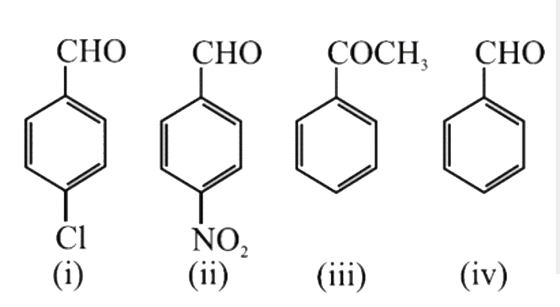Arrange the following compound in an increasing order of their reactivity in nucleophilic addition reactions : ethanal propanal, butanone, propanone.
III<II<I<IV
II<I<III<IV
IV<III<II<I
I<II<III<IV
The correct Answer is:C
Reactivity of aldehydes and ketones are mainly governed by two factors:
(i) Inductive effect : The reactivity of the carbonyl group towards the addition reactions depends upon the magnitude of the positive charge on the carbonyl carbon atom. Hence, any substituent that increases the positive charge on the carbonyl carbon must increase its reactivity towards addition reactions. The introduction of negative group (-I effect) increases the reactivity while introduction of alkyl group (+I effect) decreases the reactivity, therefore, greater the number of alkyl groups attached to the carbonyl group hence, lower is its reactivity towards nucleophilic addition reactions.
Thus, the following decreasing order of reactivity is observed :

(ii) Steric effect : In formaldehyde, there is no alkyl group while in all other aldehydes there is one alkyl group, so here the nucleophilic attack is relatively more easy, but in ketones there are two alkyl groups attached to carbonyl group and these cause hindrance to the attacking group. This factor is also called steric hindrance (crowding). In other words, as the hindrance increases, the reactivity decreases accordingly.
Thus, the order of reactivity is : IV<III<II<I.
Topper's Solved these Questions
- ALDEHYDES AND KETONESBOOK - ERRORLESSCHAPTER - ALDEHYDES AND KETONESEXERCISE - NCERT BASED QUESTIONS(PREPARATION OF ALDEHYDES AND KETONES)
36 Videos
- ALDEHYDES AND KETONESBOOK - ERRORLESSCHAPTER - ALDEHYDES AND KETONESEXERCISE - NCERT BASED QUESTIONS(PROPERTIES OF ALDEHYDES AND KETONES)
88 Videos
- ALCOHOLS, PHENOLS AND ETHERSBOOK - ERRORLESSCHAPTER - ALCOHOLS, PHENOLS AND ETHERSEXERCISE - Assertion & Reason
20 Videos
- BIOMOLECULES BOOK - ERRORLESSCHAPTER - BIOMOLECULES EXERCISE - ASSERTION & REASON
16 Videos
Similar Questions
Arrange the following compounds in an increasing order of their reactivity in nucleophilic addition reaction : ethanal, propanal, propanone, butanone.
View Solution(a) An organic compound with the molecular formula C9H10O forms 2, 4-DNP derivative, reduces Tollen's reagent and undergoes Cannizzaro reaction. On vigorous oxidation, it gives 1,2-benzenedicarboxylic acid. Identify the compound.
(B ) Arrange the following compounds in the increasing order of their reactivity in nucleophilic addition reaction : Ethanal, propanal, propanone, butanone.
(c) Although p-hydroxybenzoic acid is less acidic than benzoic acid, ortho hydroxybenzoic acid is about 15 times more acidic than benzoic acid. Explain.
View Solution
Knowledge Check
Arrange the following compounds in increasing order of their reactivity in nucleophilic addition reactions.
Ethanal, Propanal, Propanone, ButanoneAButanone lt Propanone lt Propanal lt EthanalBPropanone lt Butanone lt Ethanal gt PropanalCPropanal lt Ethanal lt Propanone lt ButanoneDEthanal lt Propanal lt Propanone lt ButanoneArrange the following carbonyl compounds in increasing order of their reactivity in nucleophilic addition reaction.
AButanone < propanane < propanal < ethanalBButanone < propanal < propanone < ethanalCButanone < ethanal < propanone < propanalDButanone < ethanal < propanal < propanoneArrange the following carbonyl compounds in increasing order of their reactivity nucleophlic addtion reactino.
AButanone < propanae < propanal < ethanalBButanone < propanal < propanone < ethanalCButanone < ethanal < propanone < propanalDButanone < ethanal < propanal < propanone
Arrange the following compounds in increasing order of their reactivity in nucleophilic addition reactions.
(i) Ethanal, Propanal, Propanone, Butanone.
(ii) Benzaldehyde, p-Tolualdehyde, p-Nitrobenzaldehyde, Acetophenone.
Hint: Consider steric effect and electronic effect.
View SolutionArrange the following carbonyl compounds in decreasing order of their reactivity in nucleophilic addition reaction :

View SolutionArrange the following carbonyl compounds in the increasing order of their reactivity in nucleophilic addition reactions :
(i) Ethanal, propanal, propanone, butane
(ii ) Benzaldehyde, p-tolualdehyde, p-nitrobenzaldehyde , acetophenone
View SolutionArrange the following compound in an increasing order of their reactivity in nucleophilic addition reactions : ethanal propanal, butanone, propanone.
View SolutionArrange the following compound in an increasing order of their reactivity in nucleophilic addition reactions : ethanal propanal, butanone, propanone.
View Solution
